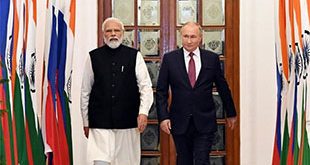
Hanoi, Vietnam | AFP-Services (text stories) | Imagine you could quench your thirst with water that doesn’t originate from a river, spring or lake, but comes directly out of the blue sky, from the air that surrounds you. What sounds like a science fiction movie is already a reality, and it is potentially for everyone.
The new technology, developed by Watergen, an Israel-based tech company, is currently being showcased in Vietnam’s capital city Hanoi. And this is how the air-to-water magic happening inside the machine works: The atmospheric water generator takes in ambient air through a filter, and cools at its dew point, extracting water through condensation. The water is then purified, mineralized, and is ready and safe to drink.
Drinking water for homes, buildings and whole villages
Watergen’s medium scale generator GEN-350 can produce an average of 600 liters of clean drinking water per day. It comes with a built-in reservoir and a water treatment system. In Vietnam, with its high air humidity, the machine can extract even more water, says Watergen President Michael Mirilashvili: “Here in Vietnam, in the three locations where we tested the technology, it performed even better than we expected.”
A large scale unit can extract up to 5000 liters per day. It is designed to provide water to approximately 2500 people per day, and it can be installed on a rooftop and connected directly to the building’s water grid. A small generator, GENNY, can provide drinking water for homes and offices, it generates 25 to 30 liters per day. The machines only need electric infrastructure to operate, and can be installed anywhere.
Watergen wants to take its technology even further: “Our scientists already developed the technology that implements the Watergen core technology inside cars, busses, trains and all kinds of transportation”, Mirilashvili says. The running vehicle will generate the power for the atmospheric water generator, to provide drinking water on the go anywhere at any time. Mirilashvili also points out that the use of atmospheric water generators could drastically reduce plastic waste.
Access to safe water during droughts
In Vietnam, a country still suffering from water shortages and poor water quality, the demand for clean water solutions is increasing, says Ambassador of Israel to Vietnam, Nadav Eshcar: “Vietnam is one of the countries most affected by global warming, suffering from droughts in the South and Central region in recent times. In Israel, we already have solutions, which we are introducing here”.
Watergen’s generator has already been in use in numerous countries around the globe, in India, the United States, Latin America, China, Russia and several African countries, to name a few. It is also being listed as one of the Technology Pioneers in 2018 by World Economic Forum.
The water generator presented at the event “Israel in the heart of Hanoi” is a gift from Watergen to the Hanoi People’s Committee. It will be on display in Ly Thai To square in the city center for a month, allowing Hanoi’s citizens to take a sip from the sky.
The exhibition coincides with a celebration of 25 years in diplomatic relations between Israel and Vietnam.
****
Info link: www.water-gen.com
 The Independent Uganda: You get the Truth we Pay the Price
The Independent Uganda: You get the Truth we Pay the Price






Nice – but not surprising. In most of Uganda, we see this water every morning in form of dew on plants. My Refrigeration and air-conditioning students down South here, have in the past made prototypes of the same – but we did not progress them to commercialisation because my interest was in lower cost technologies. I also had written something about a hotel in Cape Town which had bought a similar system in speculative planning for ‘Day Zero’ but our ‘wise’ newspapers in Ug did not find that newsworthy or even ‘suitable’ for Ug’s readership.
The low cost technologies I am talking about are to do with solar water purification. I installed a few units in Kyegegwa and Kamwenge districts last Easter. Since that time, I have developed an even simpler, foldable and portable unit. With one of my PhD students, we are now developing another which produces solar water even at night. In the coming year, I will be demonstrating these at one of the shows – and hopefully at some not too far a date, we will be making them in Kyegegwa (not Kampala please!!). Our work in this particular area is available in published papers – and for those with sufficient internet data ‘bundles’, they could view my presentation at https://www.youtube.com/watch?v=Y7NATYrJpyY
Enjoy ——
Kant Ateenyi